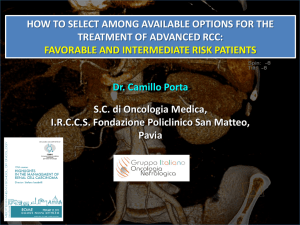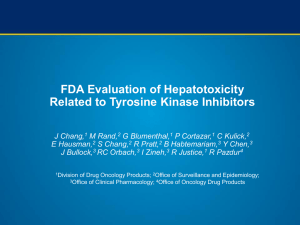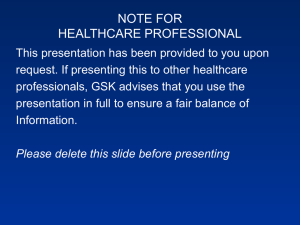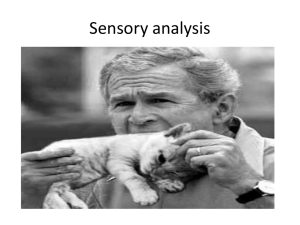pazopanib 1 - GSK UK Healthcare Professionals
advertisement
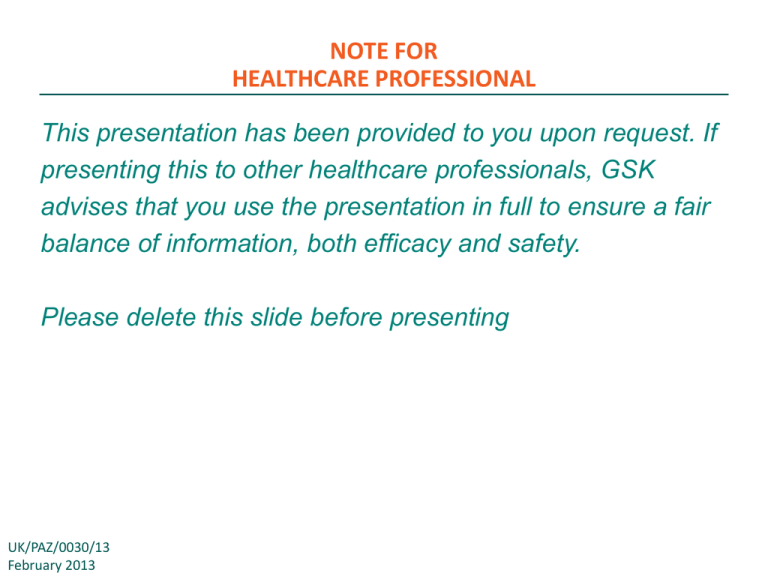
NOTE FOR HEALTHCARE PROFESSIONAL This presentation has been provided to you upon request. If presenting this to other healthcare professionals, GSK advises that you use the presentation in full to ensure a fair balance of information, both efficacy and safety. Please delete this slide before presenting UK/PAZ/0030/13 February 2013 ® PISCES PazopanIb versus Sunitinib patient preferenCE Study in treatment naïve locally advanced or metastatic renal cell carcinoma (A randomised, double-blind, cross-over patient preference study of pazopanib versus sunitinib in treatment-naïve locally advanced or metastatic renal cell carcinoma) GSK has been involved in the preparation of this presentation UK/PAZ/0030/13 February 2013 Prescribing information can be found at the end of the main presentation www.votrient.co.uk Pazopanib indication • Pazopanib is indicated in adults for the first-line treatment of advanced renal cell carcinoma (RCC) and for patients who have received prior cytokine therapy for advanced disease1 • Pazopanib’s licence is conditional pending further clinical data from GSK, including the outcome of the head-to-head study (COMPARZ) of Pazopanib versus sunitinib. 1. Votrient Summary of Product Characteristics. January 2013 Pazopanib NICE Technology Appraisal Guidance (TA 215)1 • Pazopanib is recommended as a first-line treatment option for people with advanced renal cell carcinoma • who have not received prior cytokine therapy and have an Eastern Cooperative Oncology Group (ECOG) performance status of 0 or 1 and • under the terms of the agreed Patient Access Scheme which provides pazopanib with a 12.5% discount on the list price, and a possible future rebate linked to the outcome of the head-to-head COMPARZ trial 1. NICE. Pazopanib for the first-line treatment of advanced renal cell carcinoma. Final appraisal guidance no. 215. February 2011. Pazopanib Scottish Medicines Consortium Advice No. 676/111 • Pazopanib is accepted for restricted use within NHS Scotland for the firstline treatment of advanced RCC. • This SMC advice takes account of the benefits of a Patient Access Scheme (PAS) that improves the cost-effectiveness of Pazopanib and is contingent upon the continuing availability of the PAS in NHS Scotland. 1. Scottish Medicines Consortium. Pazopanib 200mg, 400mg film-coated tablets (Votrient). Advice no. 676/11. March 2011 Patient preference as a clinical endpoint • Previous oncology trials have shown a strong association between toxicity/tolerability and quality of life (QoL), suggesting that patient preference is a useful endpoint for cross-over studies1,2 • PISCES was designed to understand how the differences in tolerability between pazopanib and sunitinib translated into a patient preference • The cross-over design allows patients to be exposed to both drugs in a comparable health state and then choose which they prefer • This is the first study of its kind in advanced renal cell carcinoma (RCC) 1. Thomas R, et al. Clin Oncol 2004;16:485-491. 2. Twelves C, et al. Ann Oncol 2006;17:239-245. Study design1 Pazopanib 800 mg OD, 10 weeks Randomisation 1:1 Double blind N-169* Sunitinib 50 mg 4/2§ 10 weeks Tablets were over encapsulated Pazopanib 800 mg OD, 10 weeks Sunitinib 50 mg 4/2§ 10 weeks *1 patient randomised in error n=168 Period 1 2-week washout (placebo) §4 weeks on, 2 weeks placebo, 4 weeks on Period 2 Off study Double-blind 0 Stratification factors Patient and physician preference (prior to unblinding & disclosure of final tumour assessment) 10 12 Time (weeks) 22 • ECOG performance status (0 vs. 1) • Number of metastatic sites (0 and 1 vs. 2+) 1. Escudier BJ, Porta C, Bono P, et al. Abstract and oral presentation at the American Society of Clinical Oncology Annual Congress 2012. J Clin Oncol 2012; 30 (suppl.): Abstract CRA4502. Study design and testing1 Randomisation 1:1 Double blind N-169* *1 patient randomised in error n=168 Pazopanib 800 mg OD, 10 weeks Sunitinib 50 mg 4/2§ 10 weeks Sunitinib 50 mg 4/2§ 10 weeks Pazopanib 800 mg OD, 10 weeks 2-week washout (placebo) Period 1 §4 weeks on, 2 weeks placebo, 4 weeks on Week Patient preference EQ-5D 0 Period 2 2 4 6 8 10 12 Off study CT CT^ CT Patient and physician preference (prior to unblinding & disclosure of final tumour assessment) 14 16 18 20 22 ^Could occur earlier if the patient crossed over early due to AE FACIT-Fatigue SQLQ 1. Escudier BJ, Porta C, Bono P, et al. Abstract and oral presentation at the American Society of Clinical Oncology Annual Congress 2012. J Clin Oncol 2012; 30 (suppl.): Abstract CRA4502. Primary endpoint1 Primary endpoint Assessed by Patient preference (pazopanib vs. sunitinib) Patient preference questionnaire • Collected at the end of treatment period 2 • Prior to unblinding • Prior to disclosure of final tumour assessment • By patients who had received ≥ 1 dose in both treatment periods • Patients selected • Which drug they preferred or whether they had no preference • The factors which influenced this preference • The most important reason for their preference • Patient preference questionnaire currently unvalidated. Developed in conjunction with Professor David Cella, USA 1. Escudier BJ, Porta C, Bono P, et al. Abstract and oral presentation at the American Society of Clinical Oncology Annual Congress 2012. J Clin Oncol 2012; 30 (suppl.): Abstract CRA4502. Other endpoints and data collected1 Other endpoints included: Assessed by: Reason for patient preference Patient preference questionnaire Health-related quality of life (QoL): - General EQ-5D - Fatigue FACIT-Fatigue scale - Mouth, throat, foot and hand soreness Supplementary QoL questionnaire (SQLQ) Dose modification & time to dose modifications Physician recorded Safety Incidence and severity of adverse events (AEs) Serious AEs Withdrawal of treatment due to AEs Other data collected: Assessed by: Physician preference Physician preference questionnaire Investigator assessed best response RECIST 1:1 Pharmacokinetics and biomarkers 1. Escudier BJ, Porta C, Bono P, et al. Abstract and oral presentation at the American Society of Clinical Oncology Annual Congress 2012. J Clin Oncol 2012; 30 (suppl.): Abstract CRA4502. Statistical design1 Assumptions • Difference of ≥ 20% in preference between agents is clinically relevant • 50% of subjects preferring one drug, 30% preferring the other, and 20% having no preference2 Target sample size of 160 patients needed • 80% power, α = 0.10 • Sample size accounted for patients lost to follow-up and those with progressive disease at end of period 1 • Analysis performed using Prescott’s test 1. Escudier BJ, Porta C, Bono P, et al. Abstract and oral presentation at the American Society of Clinical Oncology Annual Congress 2012. J Clin Oncol 2012; 30 (suppl.): Abstract CRA4502. 2. Clinical results summary for VEG113046. GSK clinical trials register: http://www.gskclinicalstudyregister.com/result_detail.jsp?protocolId=113046&studyId=5492502E-9541-4FAD-8E7E-8C4FE1AD6B49&compound=pazopanib Key inclusion and exclusion criteria1 Inclusion criteria • Locally advanced or metastatic RCC of any histology • Measurable and non-measurable disease • Treatment-naïve for metastatic RCC • ECOG performance status of 0 or 1 • Adequate cardiac and renal function Exclusion criteria • Poor MSKCC risk group • History of other malignancy • CNS metastases 1. Escudier BJ, Porta C, Bono P, et al. Abstract and oral presentation at the American Society of Clinical Oncology Annual Congress 2012. J Clin Oncol 2012; 30 (suppl.): Abstract CRA4502. Key baseline characteristics1 Age, median years (range) Male, % ECOG PS 0 vs. 1, % Nephrectomy, % Metastatic sites 1 vs. ≥ 2, % Measurable disease, % Median time since diagnosis, months (range) Clear cell histology, % Sun / Paz (n=82) Paz / Sun (n=86) Total 62 (37 – 82) 64 (29 – 83) 63 (29 – 83) 63 71 67 74 / 26 70 / 30 72 / 28 85 92 89 28 / 72 23 / 77 26 / 74 91 93 92 6.7 (1 – 222) 9.1 (0 – 241) 7.7 (0 – 241) 93 87 90 1. Escudier BJ, Porta C, Bono P, et al. Abstract and oral presentation at the American Society of Clinical Oncology Annual Congress 2012. J Clin Oncol 2012; 30 (suppl.): Abstract CRA4502. Results: Period 1 study withdrawals1 • • • • 9 Adverse event 6 Disease progression n=18 2 Withdrew consent 1 Investigator discretion Period 1 Period 2 Pazopanib N = 86 Sunitinib N = 68 Sunitinib N = 82 Pazopanib N = 68 • • • • 7 Adverse event 3 Disease progression n=14 2 Withdrew consent 2 Investigator discretion 1. Escudier BJ, Porta C, Bono P, et al. Abstract and oral presentation at the American Society of Clinical Oncology Annual Congress 2012. J Clin Oncol 2012; 30 (suppl.): Abstract CRA4502. Results: Period 2 study withdrawals and primary analysis population1 • 1 Adverse event • 5 Disease progression Period 1 n=6 PD after period 1 n=8 Period 2 Primary Analysis Population Pazopanib N = 86 Sunitinib N = 68 54 Sunitinib N = 82 Pazopanib N = 68 60 PD = progressive disease • 1 Adverse event • 2 Disease progression • 1 Other n=4 PD after period 1 n=4 • Completed questionnaire • ≥ 1 dose from each period • No PD after Period 1 1. Escudier BJ, Porta C, Bono P, et al. Abstract and oral presentation at the American Society of Clinical Oncology Annual Congress 2012. J Clin Oncol 2012; 30 (suppl.): Abstract CRA4502. Patient preference significantly favoured pazopanib1 100 90 90% CI (for difference): 37.0%-61.5%; p<0.001 80 Patients (%) 70 60 50 70% (n=80) 40 30 20 10 22% (n=25) 0 Preferred pazopanib Preferred sunitinib 8% (n=9) No preference *Question asked: “Now that you have completed both treatments, which of the two drugs would you prefer to continue to take as the treatment for your cancer, assuming that both drugs will work equally well in treating your cancer?” (patients selected either first treatment, second treatment or no preference) 1. Escudier BJ, Porta C, Bono P, et al. Abstract and oral presentation at the American Society of Clinical Oncology Annual Congress 2012. J Clin Oncol 2012; 30 (suppl.): Abstract CRA4502. Patient preference according to treatment order1 Pazopanib / sunitinib 100 100 90 90 80 80 70 70 60 50 Preference (%) Preference (%) Sunitinib / pazopanib 62% (n=37) 40 30 7% (n=4) 10 60 50 40 30 32% (n=19) 20 80% (n=43) 0 20 10 11% (n=6) 0 Preferred pazopanib Preferred sunitinib No preference Preferred pazopanib Preferred sunitinib 9% (n=5) No preference 1. Clinical results summary for VEG113046. GSK clinical trials register: http://www.gskclinicalstudyregister.com/result_detail.jsp?protocolId=113046&studyId=5492502E-9541-4FAD-8E7E-8C4FE1AD6B49&compound=pazopanib Pre-planned sensitivity analyses of patient preference1 Pazopanib Sunitinib Alpha (significance) level: 0.1 Increasing rate of preference (%) 1. Escudier BJ, Porta C, Bono P, et al. Abstract and oral presentation at the American Society of Clinical Oncology Annual Congress 2012. J Clin Oncol 2012; 30 (suppl.): Abstract CRA4502. Reasons for preference - patients who preferred pazopanib (n=80)1,2* Quality of life in general was better 65 Fatigue had less impact on my life 47 Change in food taste had less impact on my life 44 Nausea/vomiting had less impact on my life 32 Soreness in mouth/throat had less impact on my life 32 Soreness in hands/feet had less impact on my life 30 Loss of appetite had less impact on my life 28 Pain in stomach area had less impact on my life 23 Diarrhoea had less impact on my life 21 Other 14 Change in hair colour had less impact on my life *Question asked: “Please indicate which factors had an influence on your choice of treatment” (patients could select >1 reason) 9 0 10 20 30 40 50 Number of patients 60 70 80 1. Escudier BJ, Porta C, Bono P, et al. Abstract and oral presentation at the American Society of Clinical Oncology Annual Congress 2012. J Clin Oncol 2012; 30 (suppl.): Abstract CRA4502. 2. Clinical results summary for VEG113046. GSK clinical trials register: http://www.gskclinicalstudyregister.com/result_detail.jsp?protocolId=113046&studyId=5492502E-9541-4FAD-8E7E-8C4FE1AD6B49&compound=pazopanib Reasons for preference - patients who preferred sunitinib (n=25)1,2* Diarrhoea had less impact on my life 16 Quality of life in general was better 15 Fatigue had less impact on my life 12 Nausea/vomiting had less impact on my life 11 Loss of appetite had less impact on my life 10 Pain in stomach area had less impact on my life 9 Soreness in mouth/throat had less impact on my life 6 Soreness in hands/feet had less impact on my life 6 Change in food taste had less impact on my life 5 Change in hair colour had less impact on my life 5 Other 5 0 5 *Question asked: “Please indicate which factors had an influence on your choice of treatment” (patients could select >1 reason) 10 15 Number of patients 20 25 1. Escudier BJ, Porta C, Bono P, et al. Abstract and oral presentation at the American Society of Clinical Oncology Annual Congress 2012. J Clin Oncol 2012; 30 (suppl.): Abstract CRA4502. 2. Clinical results summary for VEG113046. GSK clinical trials register: http://www.gskclinicalstudyregister.com/result_detail.jsp?protocolId=113046&studyId=5492502E-9541-4FAD-8E7E-8C4FE1AD6B49&compound=pazopanib Most important reason for preference – pazopanib1* Of the 80 patients who preferred pazopanib, the most important reasons were: Fatigue had less impact on my life 21 No single reason 21 Nausea/vomiting had less impact on my life 7 Soreness in hands/feet had less impact on my life 6 Soreness in mouth/throat had less impact on my life 6 Not reported 6 Diarrhoea had less impact on my life 4 Change in food taste had less impact on my life 4 Pain in stomach area had less impact on my life 3 Loss of appetite had less impact on my life 2 Change in hair colour had less impact on my life 0 0 10 20 30 40 50 60 Number of patients 70 80 * Question asked: “If you had to choose one reason, which of the above symptoms is the most important reason for your preference?” (patients could only select one reason; If none of the symptoms were the most important reason for preference, patients could select N/A) 1. Clinical results summary for VEG113046. GSK clinical trials register: http://www.gskclinicalstudyregister.com/result_detail.jsp?protocolId=113046&studyId=5492502E-9541-4FAD-8E7E-8C4FE1AD6B49&compound=pazopanib Most important reason for preference – sunitinib1* Of the 25 patients who preferred sunitinib, the most important reasons were: No single reason 7 Diarrhoea had less impact on my life 6 Fatigue had less impact on my life 4 Nausea/vomiting had less impact on my life 3 Soreness in hands/feet had less impact on my life 2 Pain in stomach area had less impact on my life 2 Change in hair colour had less impact on my life 1 Change in food taste had less impact on my life 0 Loss of appetite had less impact on my life 0 Soreness in mouth/throat had less impact on my life 0 Not reported 0 0 5 10 15 Number of patients 20 25 * Question asked: “If you had to choose one reason, which of the above symptoms is the most important reason for your preference?” (patients could only select one reason; If none of the symptoms were the most important reason for preference, patients could select N/A) 1. Clinical results summary for VEG113046. GSK clinical trials register: http://www.gskclinicalstudyregister.com/result_detail.jsp?protocolId=113046&studyId=5492502E-9541-4FAD-8E7E-8C4FE1AD6B49&compound=pazopanib Physician preference1* 70 Physician preference (%) 60 50 61% (n=69) * Question asked: “Which of the two drugs would you prefer to be taken by the patient as the cancer treatment, assuming that both drugs will work equally well in treating the cancer?” 40 30 20 22% (n=25) 10 17% (n=19) 0 Preferred pazopanib Preferred sunitinib Physician preference based on 113 patients No preference Regardless of treatment order, physicians preferred Votrient2: • Sunitinib/pazopanib: 48% preferred pazopanib, 32% preferred sunitinib; 20% no preference • Pazopanib/sunitinib: 75% preferred pazopanib, 11% preferred sunitinib; 13% no preference 1. Escudier BJ, Porta C, Bono P, et al. Abstract and oral presentation at the American Society of Clinical Oncology Annual Congress 2012. J Clin Oncol 2012; 30 (suppl.): Abstract CRA4502. 2. Clinical results summary for VEG113046. GSK clinical trials register: http://www.gskclinicalstudyregister.com/result_detail.jsp?protocolId=113046&studyId=5492502E-9541-4FAD-8E7E-8C4FE1AD6B49&compound=pazopanib Concordance between patient and physician preference1 100 90 Preference (%) 80 70 60 50 70% 61% (n=80) 61% (n=690) (n=69) 40 22% (n=25) 30 20 10 22% (n=25) 22% (n=25) Physician Patient 0 Physician Patient Preferred pazopanib Preferred sunitinib 17% (n=19) Physician 8% (n=9) Patient No preference 1. Escudier BJ, Porta C, Bono P, et al. Abstract and oral presentation at the American Society of Clinical Oncology Annual Congress 2012. J Clin Oncol 2012; 30 (suppl.): Abstract CRA4502. Health-related quality of life1 Instrument Timing Description FACITFatigue Every 2 weeks 13 items on fatigue 3 items on (1) mouth & throat soreness (2) hand soreness (3) foot soreness SQLQ* Scale 0-52 0-3 Every 2 weeks 2 items on limitations due to (1) mouth & throat soreness (2) foot soreness 0-15 Points difference in mean scores in favour of pazopanib1,2 P-value 2.5** (mean: 38.1 paz / 35.6 sun) 0.002 0.38 (mean: 0.40 paz / 0.78 sun) <0.001 0.08 (mean: 0.21 paz / 0.29 sun) 0.026 0.16 (mean: 0.36 paz / 0.52 sun) 0.005 0.6 (mean: 14.32 paz / 13.72 sun) <0.001 0.58 (mean: 13.82 paz / 13.24 sun) 0.003 *Validation analyses ongoing ** The minimally important difference (MID) threshold is >3 points. Therefore this is not clinically meaningful 1. Escudier BJ, Porta C, Bono P, et al. Abstract and oral presentation at the American Society of Clinical Oncology Annual Congress 2012. J Clin Oncol 2012; 30 (suppl.): Abstract CRA4502. 2. Clinical results summary for VEG113046. GSK clinical trials register: http://www.gskclinicalstudyregister.com/result_detail.jsp?protocolId=113046&studyId=5492502E-9541-4FAD-8E7E-8C4FE1AD6B49&compound=pazopanib EQ5D data1 • The EQ-5D data presented at ESMO 2012 were inconclusive • EQ-5D assessment showed that utility scores deteriorated in pazopanib-treated patients in treatment period 1, but the deterioration in period 2 was numerically greater in sunitinib-treated patients compared with those on pazopanib 1. Cella D, Kaiser K, Beaumont J, et al. Quality of life (QOL) among renal cell carcinoma (RCC) patients in a randomised double blind cross-over patient preference study of pazopanib (P) versus sunitinib (S). Abstract and poster presentation at European Society of Medical Oncology Congress 2013. Abstract no. 792PD Dose modifications1 Pazopanib Sunitinib Patients with dose reductions* 13% 20% Prematurely discontinued from Period 1 due to AE’s** Prematurely discontinued from Period 2 due to AE’s*** 14% 15% 18% 31% *Across period 1 + period 2: Pazopanib n=153 (patients who received at least one dose of pazopanib) Sunitinib n=148 (patients who received at least one dose of sunitinib) ** n=86 (pazopanib): n=82 (sunitinib) i.e. n=168 patients (All randomised population: number of patients who were randomised to treatment and entered period 1) *** n=68 (pazopanib): n=68 (sunitinib) i.e. n=136 (Intent-to-treat population: Patients who received at least one dose of drug from each treatment period i.e. those who entered treatment period 2) 1. Escudier BJ, Porta C, Bono P, et al. Abstract and oral presentation at the American Society of Clinical Oncology Annual Congress 2012. J Clin Oncol 2012; 30 (suppl.): Abstract CRA4502. Most common AEs irrespective of causality (≥15%)1 Pazopanib (n = 153) Adverse Event Any AE Diarrhoea Nausea Decreased appetite Vomiting Dyspepsia Dysgeusia Mucositis Stomatitis Hand-foot syndrome Hair colour changes Hypertension Asthenia Fatigue All Grades 97% 42% 33% 20% 14% 10% 16% 16% 5% 16% 17% 23% 16% 29% Grade 3/4 38% < 1% < 1% 0 < 1% 0 0 0 < 1% 1% 0 8% < 1% 4% Sunitinib (n = 148) All Grades > 99% 32% 30% 19% 16% 16% 27% 22% 16% 26% 14% 26% 24% 30% Grade 3/4 47% < 1% 0 <1% < 1% 0 0 1% 2% 4% 0 9% 3% 5% Subjects who have received at least one dose of either drug. Graded by Investigators according to National Cancer Institute - Common Toxicity Criteria of Adverse Events, Version 4.0 (NCI-CTCAE v4.0) 1. Escudier BJ, Porta C, Bono P, et al. Abstract and oral presentation at the American Society of Clinical Oncology Annual Congress 2012. J Clin Oncol 2012; 30 (suppl.): Abstract CRA4502. Clinical laboratory abnormalities1 Pazopanib (n = 153) Sunitinib (n = 148) Parameter ALP elevations Any Grade Grade 3/4 Any Grade Grade 3/4 18% 1% 20% 0% ALT elevations 39% 7% 28% 3% AST elevations 38% 4% 44% < 1% Total bilirubin elevations 24% < 1% 12% 0% Albumin elevations 10% 2% 20% 1% Creatinine elevations 34% 0 15% 0% Anaemia 11% 1% 25% < 1% Lymphopenia 17% 0 35% 8% Neutropenia 13% 1% 45% 7% Thrombocytopenia 15% 0 47% 5% Leukopenia 15% 0 49% 1% Subjects who have received at least one dose of either drug. Graded by Investigators according to National Cancer Institute - Common Toxicity Criteria of Adverse Events, Version 4.0 (NCI-CTCAE v4.0) 1. Escudier BJ, Porta C, Bono P, et al. Abstract and oral presentation at the American Society of Clinical Oncology Annual Congress 2012. J Clin Oncol 2012; 30 (suppl.): Abstract CRA4502. PISCES summary • Significantly more patients preferred pazopanib over sunitinib (70% vs. 22%; p<0.001), with the remaining 8% of patients expressing no preference for either treatment • The most important reason for preferring pazopanib was less fatigue or no single reason • The most important reason for preferring sunitinib was no single reason • High level of concordance between patient and physician preference, with 61% of physicians preferring pazopanib over sunitinib (22% preference) • FACIT-fatigue tool showed that patients experienced statistically significantly less fatigue on pazopanib than sunitinib (mean scores differed by 2.5 points, p=0.002). However, this did not achieve the minimally important difference (MID) threshold of >3 points. • SQLQ showed patients experienced less hand, foot and mouth/throat soreness with pazopanib than sunitinib. Mean scores favoured pazopanib PISCES summary • Notable differences in some AEs between pazopanib and sunitinib include: • Diarrhoea (more frequent with pazopanib; 42% vs. 32%) • Stomatitis (more frequent with sunitinib; 16% vs. 5%) • Mucositis (more frequent with sunitinib; 22% vs. 16%) • Hand-foot syndrome (more frequent with sunitinib; 26% vs. 16%) • Asthenia (more frequent with sunitinib; 24% vs. 16%) • Interestingly, the incidence of fatigue as recorded as an AE was similar between the two drugs (29% vs. 30%) • Greater incidence of haematological toxicity with sunitinib • Pazopanib was associated with fewer dose reductions and discontinuations due to AEs Posology and special warnings (1)1 • Please refer to full SmPC before prescribing • Votrient tablets should be taken – 800mg daily – Whole (not broken or crushed) – Without food - at least 1 hour before or 2 hours after a meal • Dose modifications – Should be in 200mg decrements/increments • Drug interactions – The concomitant use of strong CYP3A4 inhibitors and inducers, UGT1A1 substrates and medicines that increase gastric pH, should be avoided unless medically necessary. – Concomitant use of simvastatin (and potentially other statins) can increase risk of ALT elevations and should be undertaken with caution and close monitoring • Renal impairment – No dose adjustment is required in patients with creatinine clearance >30 ml/min – Caution is advised in patients with creatinine clearance <30 ml/min 1. VOTRIENT Summary of Product Characteristics. January 2013. Posology and special warnings (2)1 • Hepatic impairment & Hepatic effects – Cases of hepatic failure have been reported during Votrient use – Votrient is not recommended in patients with severe hepatic impairment – Use with caution and close monitoring in patients with mild or moderate hepatic impairment – Patients with mild hepatic impairment should be treated with 800mg once daily – A reduced dose of 200 mg once daily is recommended in moderate hepatic impairment – Serum liver tests should be monitored at baseline, at least once every 4 weeks for the first 4 months of treatment, and as clinically indicated with periodic monitoring thereafter. – More frequent monitoring, dose interruption, modification or discontinuation may be warranted if liver test abnormalities are detected. • Hypertension – Blood pressure should be well controlled prior to initiating Votrient – Patients should be monitored for hypertension within 1 week of starting treatment and frequently thereafter to ensure blood pressure control – Hypertension should be managed using a combination of anti-hypertensive therapy and dose modification of Votrient (interruption and re-initiation at a reduced dose based on clinical judgement) – Events of hypertensive crisis have occurred during clinical studies with Votrient (<1% of patients) – Votrient should be discontinued if there is evidence of persistently elevated blood pressure (140/90 mmHg) or if arterial hypertension is severe and persists despite antihypertensive therapy and Votrient dose reduction 1. VOTRIENT Summary of Product Characteristics. January 2013. Posology and special warnings (3)1 • PRES / RPLS – Posterior reversible encephalopathy syndrome (PRES)/Reversible posterior leukoencephalopathy syndrome (RPLS) has been reported in association with pazopanib. – PRES/RPLS can present with headache, hypertension, seizure, lethargy, confusion, blindness and other visual and neurological disturbances, and can be fatal – Patients developing PRES/RPLS should permanently discontinue pazopanib • Cardiac dysfunction/heart failure – The safety and pharmacokinetics of Votrient in patients with moderate to severe heart failure or those with a below normal left ventricular ejection fraction (LVEF) has not been studied – In clinical trials with pazopanib, events of cardiac dysfunction such as congestive heart failure and decreased left ventricular ejection fraction have occurred. – The risks and benefits of Votrient should be considered before beginning therapy in patients who have pre-existing cardiac dysfunction – Baseline & periodic evaluation of LVEF is recommended in patients at risk of cardiac dysfunction – Patients should be carefully monitored for clinical signs or symptoms of congestive heart failure – Interruption of Votrient and/or dose reduction should be combined with treatment of hypertension in patients with significant reductions in LVEF, as clinically indicated • Thrombotic microangiopathy (TMA) – Thrombotic microangiopathy (TMA) has been reported in clinical trials of pazopanib as monotherapy, in combination with bevacizumab, and in combination with topotecan – Patients developing TMA should permanently discontinue pazopanib; reversal of effects of TMA has been observed after pazopanib treatment was discontinued 1. VOTRIENT Summary of Product Characteristics. January 2013. Posology and special warnings (4)1 • Other warnings – Events of pneumothorax have occurred in clinical studies with Votrient in advanced soft tissue sarcoma. Patients on Votrient should be observed closely for signs and symptoms of pneumothorax – Venous thromboembolic events (VTEs) including venous thrombosis and pulmonary embolus have occurred in clinical studies with Votrient (incidence of 2% in RCC studies and 5% in STS studies) – Use with caution in patients who are at increased risk for arterial thrombotic events, those with significant risk of haemorrhage, GI perforation or fistula. Votrient is not recommended in patients with a history of haemoptysis, cerebral or clinically significant GI haemorrhage in the past 6 months. – Use with caution in patients with a history of QT interval prolongation, those taking antiarrhythmics or with pre-existing cardiac disease. Baseline and periodic monitoring of electrocardiograms and maintenance of electrolytes within normal range is recommended. – Votrient may impair wound healing, and should be stopped at least 7 days prior to scheduled surgery – Hypothyroidism has occurred in clinical studies with Votrient. Baseline and periodic monitoring is recommended. – Proteinuria has occurred in clinical studies with Votrient. Baseline and periodic urinalysis is recommended, with discontinuation of Votrient if the patient develops grade 4 proteinuria – Cases of serious infection (with/without neutropenia) have been reported – Combination with other systemic anti-cancer therapies: Safe and effective dose in combination with pemetrexed or lapatinib has not been established 1. VOTRIENT Summary of Product Characteristics. January 2013. Posology and special warnings (5)1 • Instances where Votrient should be permanently discontinued include: – – – – – • In patients with re-occurrence of elevated transaminases (>3 x ULN) following treatment interruption, or with aminotransferases elevations >3 x ULN and bilirubin elevations >2 x ULN, where direct bilirubin fraction >35% In patients with persistently elevated blood pressure or if hypertension is severe and persists despite antihypertensive therapy and Votrient dose reduction In patients with wound dehiscence In patients with grade 4 proteinuria In patients developing PRES/RPLS or TMA Serious adverse events have been associated with Votrient, with the most important events each being reported in <1% of treated patients 1. VOTRIENT Summary of Product Characteristics. January 2013. Prescribing Information (Please refer to full SmPC before prescribing) Votrient®▼(pazopanib) 200mg and 400mg film-coated tablets. Each tablet contains pazopanib hydrochloride, equivalent to 200mg and 400mg of pazopanib, respectively. Indication In adults for first-line treatment of advanced renal cell carcinoma (RCC) and those with prior cytokine therapy. Dosage and administration Only to be initiated by physician experienced in use of anti-cancer agents. 800mg once daily. Take without food (≥1 hour before or ≥2 hours after a meal). Take tablets whole; do not break or crush. Dose modification: In 200mg steps based on individual tolerability to manage ADRs. Not to exceed 800mg. Renal impairment: No dose adjustment required in patients with CrCl >30ml/min. Caution advised in patients with CrCl <30ml/min. Hepatic impairment: Severe hepatic impairment - Not recommended. Undertake with caution and close monitoring in mild/moderate impairment. Mild impairment - 800mg once daily; Moderate impairment 200mg once daily. Elderly: Limited data in patients ≥ 65 yrs. Paediatrics: Not to be used in children <2 yrs. Safety & efficacy not established in children 2-18 yrs; no data available. Contra-indications Hypersensitivity to active substance or excipients. Special Warnings and Precautions Hepatic effects: Hepatic failure reported during pazopanib use; increases in serum transaminases (ALT, AST) and bilirubin also observed. Monitor liver function before initiation of treatment and ≥once every 4 weeks for first 4 months, and periodically thereafter. If transaminases ≤8xULN, continue pazopanib with weekly monitoring until they return to ≤Grade 1. If transaminases >8xULN, interrupt pazopanib until they return to ≤Grade 1. If transaminases >3xULN occur following re-introduction, discontinue pazopanib. If transaminases >3xULN occur concurrently with bilirubin >2xULN, perform bilirubin fractionation. If direct (conjugated) bilirubin is >35% of total, discontinue pazopanib. Concomitant use of pazopanib and simvastatin increases risk of ALT elevations: undertake with caution and close monitoring. Hypertension: Events of hypertension, including hypertensive crisis, have occurred in pazopanib studies. Control BP prior to initiating pazopanib. Monitor for hypertension early (≤1 week after starting treatment) and frequently thereafter. Manage elevated BP with anti-hypertensive therapy and pazopanib dose modification. Discontinue pazopanib if BP is persistently elevated (140/90 mmHg) or if arterial hypertension is severe and persists despite anti-hypertensive therapy and dose reduction. Posterior reversible encephalopathy syndrome (PRES) / Reversible posterior leukoencephalopathy syndrome (RPLS): PRES/RPLS has been reported in association with pazopanib. Patients developing PRES/RPLS should permanently discontinue pazopanib. Cardiac dysfunction/heart failure: Consider risks/benefits of pazopanib in patients with preexisting cardiac dysfunction. Safety and pharmacokinetics of pazopanib not studied in patients with moderate to severe heart failure or those with below normal LVEF. Events of cardiac dysfunction (e.g. CHF and LVEF decline) have occurred in pazopanib trials. Monitor patients for signs and symptoms of CHF. Baseline and periodic LVEF evaluation recommended. QT prolongation and Torsade de Pointes: Use with caution in patients (i) with history of QT interval prolongation, (ii) taking antiarrythmics or other medications that may prolong QT interval or (iii) with relevant pre-existing cardiac disease. Baseline and periodic ECGs, and maintenance of electrolytes within normal range recommended. Arterial thrombotic events: Use with caution in patients at increased risk for these events. Base treatment decision on individual patient’s benefit/risk assessment. Venous thromboembolic events (VTEs): VTEs including venous thrombosis and fatal PE have occurred in pazopanib trials. Thrombotic microangiopathy (TMA): (including thrombotic thrombocytopenic purpura and haemolytic uraemic syndrome) has been reported in clinical trials of pazopanib. Patients developing TMA should permanently discontinue pazopanib. Reversal of effects of TMA has been observed after pazopanib treatment was discontinued. Haemorrhagic events: Not recommended in patients with history of haemoptysis, cerebral, or significant GI haemorrhage in past 6 months. Use with caution in patients with significant risk of haemorrhage. GI perforations and fistula: Use with caution in patients at risk for GI perforation or fistula. Wound healing: Stop treatment ≥7 days prior to surgery. Resume after surgery based on clinical judgement of adequate wound healing. Discontinue pazopanib in patients with wound dehiscence. Hypothyroidism: Baseline measurement of thyroid function recommended prior to start of pazopanib treatment; monitor periodically during treatment. Monitor patients for signs and symptoms of thyroid dysfunction and manage as per standard medical practice. Proteinuria: Baseline and periodic urinalysis recommended. Monitor patients for worsening proteinuria. Discontinue pazopanib if Grade 4 proteinuria develops. Pneumothorax: Observe patients closely for signs and symptoms of pneumothorax. Infections: Cases of serious infection (with/without neutropenia) reported. Interactions Avoid concomitant use with strong inhibitors of CYP3A4, pglycoprotein (P-gp) or breast cancer resistance protein (BCRP) and CYP3A4 inducers. Hyperglycaemia observed during concomitant administration with ketoconazole. Avoid coadministration with medicines that increase gastric pH (e.g. PPIs and H2 receptor antagonists) unless medically necessary. Undertake concomitant administration with uridine diphosphate glucuronosyl transferase 1A1 (UGT1A1) substrates and simvastatin (and other statins) with caution. Avoid grapefruit juice during pazopanib treatment. Pregnancy and lactation No adequate data on use in pregnant women. Not to be used unless clearly necessary; appropriate contraception advised. Not known whether pazopanib excreted in human milk; breastfeeding should be discontinued. Animal studies indicate fertility may be affected. Effects on ability to drive and use machines No studies conducted. Avoid driving or using machines if affected. Undesirable effects Most important serious ADRs associated with pazopanib in clinical studies were: TIA, ischaemic stroke, myocardial ischaemia, myocardial and cerebral infarction, cardiac dysfunction, GI perforation and fistula, QT prolongation; pulmonary/GI/cerebral haemorrhage. All events occurred in <1% of patients. Fatal events possibly related to pazopanib included: GI haemorrhage, pulmonary haemorrhage/haemoptysis, abnormal hepatic function, intestinal perforation, ischaemic stroke. Treatment-related events reported with pazopanib in advanced RCC patients with following frequencies: Very common: Decreased appetite; Dysgeusia; Hypertension; Diarrhoea, nausea, vomiting, abdominal pain; Hair colour changes; Fatigue; Increased ALT and AST. Common: Thrombocytopenia, neutropenia, leucopenia; Hypothyroidism; Headache, dizziness, lethargy, paraesthesia; Hot flush; Epistaxis, dysphonia; Dyspepsia, stomatitis, flatulence, abdominal distension; Abnormal hepatic function, hyperbilirubinaemia; Rash, alopecia, PPE, skin hypo/de-pigmentation, erythema, pruritus, dry skin, hyperhidrosis; Myalgia, muscle spasms; Proteinuria; Asthenia, mucosal inflammation, oedema, chest pain; Decreased weight /WBC, Increased creatinine/bilirubin/lipase/BP/TSH/GGT. Uncommon events include: Hypophosphataemia; hypomagnesaemia; Peripheral sensory neuropathy; hypoaesthesia; Eyelash discolouration; CVA, myocardial infarction, bradycardia; Flushing, hypertensive crisis; Mouth ulceration, frequent bowel movements; pancreatitis, peritonitis; Hepatotoxicity, hepatic failure, hepatitis; jaundice; Photosensitivity reaction, skin exfoliation; Menorrhagia, metrorrhagia, Retroperitoneal/urinary tract/vaginal haemorrhage; Mucous membrane disorder; Increased blood urea/amylase, decreased blood glucose, abnormal thyroid function test; Infections (with/without neutropenia). Overdose No specific antidote. Treatment should consist of general supportive measures. Basic NHS Cost 200mg x 30 tablet pack £560.50. 400mg x 30 tablet pack £1121.00. Marketing authorisation (MA) nos. EU/1/10/628/001-4. MA holder Glaxo Group Limited, Berkeley Avenue, Greenford, Middlesex UB6 ONN. Legal category POM. UK/PAZ/0012/13. January 2013. Adverse events should be reported. Reporting forms and information can be found at: http://www.mhra.gov.uk/yellowcard Adverse events should also be reported to GlaxoSmithKline on 0800 221 441. Further information is available from Customer Contact Centre, GlaxoSmithKline, Stockley Park West, Uxbridge, Middlesex UB11 1BT; customercontactuk@gsk.com; Freephone: 0800 221 441. Votrient is a trademark of the GlaxoSmithKline group of companies. Additional slides Patient preference questionnaire - question 1 1. Now that you have completed both treatments, which of the two drugs would you prefer to continue to take as the treatment for your cancer, assuming that both drugs will work equally well in treating your cancer? (place a tick mark ( ) for ONLY one response) Prefer the drug taken as the first treatment – Please answer questions 2-3 Prefer the drug taken as the second treatment – Please answer questions 2-3 Have no preference – if you have no preference, you need not answer questions 2-3 Patient preference questionnaire - question 2 2. Below are some factors that may have influenced your treatment preference. Please indicate which factors had an influence on your choice of treatment. Patient preference questionnaire - question 3 3. If you had to choose one reason, which of the above symptoms is the most important reason for your preference? (please circle only one letter or “N/A” for “not applicable”, if none of the listed symptoms were the most important reason for your preference) A B C D E F G H I N/A Other endpoints and data collected – how were they assessed? EQ-5D • Collected on day one, wash out period and end of study. • Standardised, validated measure of health status. FACIT-Fatigue • Completed on day one, every two weeks during treatment and end of the study. • Validated tool which measures the severity and impact of fatigue on functioning and health-related quality of life experienced in the past seven days. SQLQ • Completed on day one, every two weeks during treatment and at the end of the study. • Designed to assess the severity and impact of a patient’s mouth and throat soreness as well as hand and foot soreness. • Unvalidated questionnaire, developed in collaboration with Professor David Cella. Physician preference • Prospectively collected at the end of treatment period 2, prior to unblinding. • Physicians selected which drug they preferred the patient to carry on taking and the reasons for this. Tumour response • Scans collected at baseline, wash out period and end of study. Participating countries and UK recruitment 70 62 Patients numbers 60 50 40 40 37 30 20 16 14 10 0 Finland France Germany Italy UK UK centres • The Christie, Wolverhampton, Plymouth, Hull, Newcastle, Shrewsbury, Norwich, Birmingham and Preston Investigator-assessed best unconfirmed response per RECIST v1.1 End of treatment period 11 – collected for analysis purposes Best response Pazopanib (n=85) Sunitinib (n=80) Complete response (CR) 1% 1% Partial response (PR) 18% 20% Stable disease** 42% 53% Progressive disease 20% 11% Not evaluable 20% 15% 19% 12.2%-27.2% 21% 14.0%-30.2% Objective response (CR + PR) 90% CI Difference in response rate2 90% CI for difference2 P-value2 -2.4 (-12.7, 7.8) 0.703 **Includes non-CR/non-PD for patients with non measurable disease • Study population (n=168) included patients with non-clear cell RCC histology (10.1%) and non-measurable disease (7.7%) 1. Escudier BJ, Porta C, Bono P, et al. Abstract and oral presentation at the American Society of Clinical Oncology Annual Congress 2012. J Clin Oncol 2012; 30 (suppl.): Abstract CRA4502. 2. Clinical results summary for VEG113046. GSK clinical trials register: http://www.gskclinicalstudyregister.com/result_detail.jsp?protocolId=113046&studyId=5492502E-9541-4FAD-8E7E-8C4FE1AD6B49&compound=pazopanib
